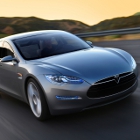
The Tesla motor has only one moving piece: the rotor. As a result, Model S acceleration is instantaneous, like flipping a switch. Hit the accelerator. In 5.6 seconds, Model S is traveling 60 miles per hour, without hesitation and without a drop of gasoline.
Equipped with the 85 kilowatt-hour battery and a high performance drive inverter, Model S Performance accelerates to 96.5 kph (60 mph) in 4.4 seconds. If driven the same way as Model S, both cars achieve the same efficiency thanks to the unique powertrain design.
The Tesla Model S replaced the Tesla Roadster.
Battery
Tesla uses Lithium-ion battery technology. These batteries do not suffer from “memory effect”.
The Tesla Model S is offered with three battery options, each achieving unprecedented range. Tesla starts with about seven thousand automotive-grade Lithium-ion cells and assembles them into a liquid-cooled battery strategically positioned in the floor of the car. The Model S battery builds on the Tesla Roadster’s pioneering architecture and more than 15 million miles of real world driving.
The Model S battery pack will not lose a significant amount of charge when parked for long periods of time. For example, Model S owners can park at the airport for extended vacations without plugging in.
Accessory use does not have a dramatic impact on driving range. Range fluctuates based on vehicle speed, driving style, and road conditions. Holding these factors constant, using higher consumption accessories like climate control will reduce range approximately five to ten percent.
Model S is designed to regenerate charge when decelerating or driving downhill.
Tesla expects the battery to retain approximately 70% of its initial capacity after seven years (or 100,000 miles).
Given rapidly changing battery technology, it is impossible to accurately forecast the cost of future battery replacements.
Charging
Model S plugs into any standard outlet. The charge port is hidden from sight in the driver’s side rear taillight.
220V outlets, like the ones used to power a dryer, charge Model S more quickly than a standard 110V outlet. Tesla recommends plugging your Model S in each night or when convenient to maintain optimum driving range and battery health.
Many utilities offer lower rates for off-peak energy consumption, making charging your Tesla at night even more affordable.
Model S is not currently designed to incorporate the use of solar panels on the vehicle. Customers can use home solar panels to charge Model S. If you’re interested in installing a home solar system to charge your Tesla, we recommend working with a local solar installer to develop and install a system that supports your total daily energy demand.